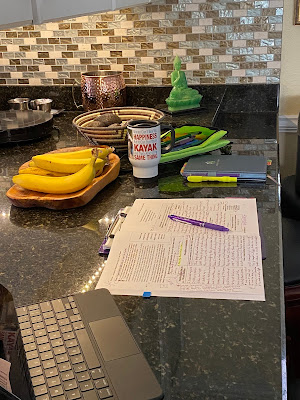"Discovering the truth about ourselves
is a lifetime's work, but worth the effort."
-- Fred Rogers
It’s common …
- words said
- actions taken
- feelings hurt
- anger sparked.The particular details of my breakup aren’t all that interesting nor unusual. A 30-year friendship blew up in a lightning strike of stress, misunderstanding, and insecurities, leaving a burned out shell in an empty field.
My reaction was a spiraling whirlwind of emotions: disbelief, anger, hurt, abandonment, sadness, and rejection as I wanted to lash out, shut down, wallow in self-pity, and hurt her back. Another friend has been coaching me on recognizing and naming my emotions. Suddenly, I was flooded with a whole dictionary of them.
I proceeded to a self-satisfying round of rehashing and re-storying the whole precipitating event, building up my sense of righteousness and driving my stake deeper into moral high ground. I wrote mental letters defending myself, spun spiteful fantasies, imagined future groveling on her part, which, in my fairy princess mode, I would either accept or reject with a simple wave of my wand as I flitted off to other sky castles.
Fortunately, I also took more productive action by writing in my gratitude journal. Gratitude Mojo, the gratitude journal a friend and I are creating and using as we continue along this journey, has what we call “dot pages,” blank, dotted pages with nothing other than an inspiring quote on them. I began to fill up dot pages with mindmaps and lists focusing on what happened and our history together.
"Everything is a gift!"
-- David Steindl-Rast
I put a virtual “Everything is a gift!” sticker on it, gave myself a gold star for being enlightened, and felt better. I thought I was done. Wrong.
Rehashing the past and re-storying the future continued. I definitely wasn’t being attentive to the present moment and soon realized there were old wounds being poked. My standard way of dealing with emotions and my emotional history was to stuff them in the closet and turn to “doing” … writing, researching, planning … escaping.
However, every day, Gratitude Mojo asked me the same question: what am I grateful for? and waited for an answer … those blank spaces just sitting there patiently awaiting my response. And every day for weeks, I responded with things outside the wound. My life is amazing and there are a zillion things to be grateful for. I thought expressing gratitude for my beautiful life would make the hurt go away.
While it did dampen intensity, there was still this black hole sucking energy into its center. My imagination kept creating future stories … possible apologies, potential reconnections, dramatic scenes of triumph and payback.
As Leonard Cohen says so beautifully, “There is a crack in everything; that’s how the light gets in.” One day, with about an hour and a half of driving in front of me, a bit of light peeked through a crack as I turned on a tape of Candace Pert talking about the molecules of emotion. Candace was the scientist who discovered the opiate receptor as a graduate student and went on to posit that the body is our subconscious mind. What I heard on that tape was that emotions are real; they are part of the soup that runs our body. We need to pay attention to them.
This wasn’t the first time I had heard this, of course; I had read her book Molecules of Emotion decades before. On this day however, the message struck a new chord and pulled me into thinking about emotions, my emotions, and how their dance around this drama with my friend were binding me to a host of negative emotions. No wonder I was suddenly craving sugar.
It challenged me to think more deeply about my history, my emotional history, and its role in this conflict. Out of that struggle, I began to believe that the gratitude journal needed to include information and space for regularly exploring our emotions, these critically important pieces of our being.
So, a new page was developed and I began to use it and see this breakup, and my friend, as change agents in my life, giving me a chance to re-examine, and possibly heal, a wound from childhood.

Years ago I had created an intention bracelet with six major beads, so I turned it into an artifact to help me focus on and understand which emotions were in play whenever something new came up. Today, while writing in my gratitude journal I realized that my feelings had shifted.
Rather than focusing on proving myself right, I reconnected with my long history with this friend and just wanted to feel compassion for what she was going through (she had recently lost her husband) and leave the door open to whatever future direction our friendship might take.
At the same time, I am committed to befriending myself with compassion and not burying my emotions for the sake of keeping someone else happy or maintaining “peace.”
I know the journey isn’t over, however, some lessons are already clear:
- it doesn’t matter who started the drama.
- the fodder for the fire of conflict builds up over time like forest undergrowth, waiting for the spark which becomes a wildfire. Honest, open conversation is relationship maintenance, cleaning away the flammable debris.
- emotions are in play whether or not we want them to be. The actions we take, however, are choices we make and are best made on the basis of what we truly value.
- people change, life circumstances change, someone else’s actions are not about me and I should not take them personally.
Positive Action Possibilities
Possible ways out of rehashing or ruminating are offered by Linda Wasmer Andrews in an article published by EverydayHealth.com. She suggests distracting yourself, stating that even eight minutes of distraction can break the cycle and lift your mood. Try physical activity (my favorite is dancing around the house to music with an intense beat), hobbies, or any form of play. You could also brainstorm small steps to get past whatever you’re stuck on … or write your gratitudes in your gratitude journal!
As for me, I will most likely need to read this article more than once as I continue to learn the lessons my emotions offer me.
Gratitude Mojo is the new, advanced journal for gratitude practice which takes you even deeper into the amazing gifts of gratitude.
Gratitude Miracles, the 5-minute journal that could change everything! is available at amazon.com. Click Here.
Reference:
“Overthinking? It Could Be Depressing You,”
Linda Wasmer Andrews November 14, 2017



















